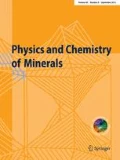Abstract
A theoretical concept is outlined, which links the kinetics of structural transformations with thermodynamic theories of structural phase transitions. Starting from Landau theory and Markovian processes, the general rate laws for crystals with long correlation lengths are derived. The rate laws in Ginzburg-Landau theory are
and Q 2∝ for T ≈ T c . The physical meaning of the time constant τ and the correction term f(Q) are explained. Fluctuations of the order parameter lead to damping behaviour with explicit dependence on the wavelength of the fluctuation wave and modulation-dependent variations of the lattice strain.
Lattice relaxations and activation processes are discussed. Typical rate laws are found to follow
which leads for short time intervals to a linear rate law
It is shown that linear terms in the Landau potential are equivalent to a logarithmic decay of the excess entropy ΔS ∝ ln Δt which is also expected to be the dominant rate law in field-induced pseudo-spin glasses:
Fluctuations lead to spatially heterogeneous distributions of the order parameter. A two phase field is found in this case where the nucleation energy is overcome by fluctuation processes.
Random fields, arising, for example, from lattice imperfections, lead also to spacially inhomogeneous material. The dominant microstructure is the lattice modulation mostly in the form of a cross hatched pattern (tweed) but also in the form of incommensurate modulations.
Similar content being viewed by others
References
Anderson PW, Halperin BI, Varma CM (1972) Anomalous low temperature thermal properties of glasses and spin glasses. Philos Mag 25:1–9
Anisimov MA, Gorderskii EE, Zaprudskii VM (1981) Phase transitions with coupled order parameters, Sov Phys Usp 24:57–75
Binder K, Young AP (1986) Spin glasses: Experimental facts, theoretical concepts and open questions. Rev Modern Phys 58:801–976
Bray AJ, Moore MA (1979) Replica symmetry and massless modes in the Ising spin glass, J Phys C12:79–104
Bray AJ, Moore MA (1982) Spin glasses: the hole story. J Phys C15:2417–2440
Bruce AD, Cowley RA (1981) Structural phase transitions. Taylor and Francis, London
Bruce AD, Schneider T, Stoll E (1979) Cluster phenomena and the displacive to order-disorder crossover. Phys Rev Lett 43:1284–1287
Cook HE, Hilliard JE (1969) Effect of gradient energy on diffusion in gold-silver alloys. J Appl Phys 40:2191–2198
Cowley RA (1976) Acoustic phonon instabilities and structural phase transitions. Phys Rev B13:4877–4885
Dasgupta CF, Ma K, Hu CK (1979) Dynamic properties of a spinglass model at low temperature. Phys Rev B20:3837–3849
Glauber RJ (1963) Time-dependent statistics of the Ising model. J Math Phys 4:294–307
Khachaturyan AG (1983) Theory of structural transformations in solids. J Wiley, New York
Langer JS (1971) Theory of spinodal decomposition in alloys. Ann Phys 65:53–85
Lines ME, Glass AM (1977) Principles and applications of ferroelectric and related materials. Clarendon Press, Oxford
Mc Connell JDC (1988) Thermodynamics of short range order; published in: Salje E (ed) Physical Properties and Thermodynamic Behaviour of Minerals. Reidel, Dordrecht
Metiu H, Kitahara K, Ross J (1976a) A derivation and comparison of two equations (Landau-Ginzburg and Cahn) for the kinetics of phase transitions. J Chem Phys 65:393–396
Metiu H, Kitahara K, Ross J (1976b) Stochastic theory of the kinetics of phase transitions. J Chem Phys 64:292–299
Michel KH (1984) Phase transitions in strongly anharmonic and orientationally disordered crystals. Z Phys B54:129–137
Michel KH, Rowe JM (1980) Existence of an orientational glass state in (KCN) x (KBr)1−x mixed crystals. Phys Rev B22:1417–1428
Putnis A, Salje E, Redfern SAT, Fyfe CA, Strobl H (1987) Structural states of Mg-cordierite I: Order parameters from Synchrotron X-ray and NMR data. Phys Chem Minerals 14:446–454
Reger JD, Binder K (1985) Dynamics of Ising spin glasses far below the lower critical dimension: the one-dimensional case and small clusters. Z Phys B60:137–150
Salje E, Kuscholke B, Wruck B (1985) Domain wall formation in minerals: I. Theory of twin boundary shapes in Na-feldspar. Phys Chem Minerals 12:132–140
Salje E, Devarajan V (1985) Phase transitions in systems with strain-induced coupling between two order parameters. Phase Transitions 6:235–248
Salje E (1987) Structural changes of Mg-cordierite II: Landau theory. Phys Chem Minerals 14:455–460
Tsakalakos T (1977) as cited by Khachaturyan (1983), p 134
Wong YM, Meijer HE (1982) A memory function equation approach to the kinetics of spinodal decomposition in the very early linear regime. Physica 110A:188–200
Zook JD, Liu ST (1976) Use of effective field theory to predict relationships among ferroelectric parameters. Ferroelectrics 11:371–376
Author information
Authors and Affiliations
Rights and permissions
About this article
Cite this article
Salje, E. Kinetic rate laws as derived from order parameter theory I: Theoretical concepts. Phys Chem Minerals 15, 336–348 (1988). https://doi.org/10.1007/BF00311038
Received:
Issue Date:
DOI: https://doi.org/10.1007/BF00311038



